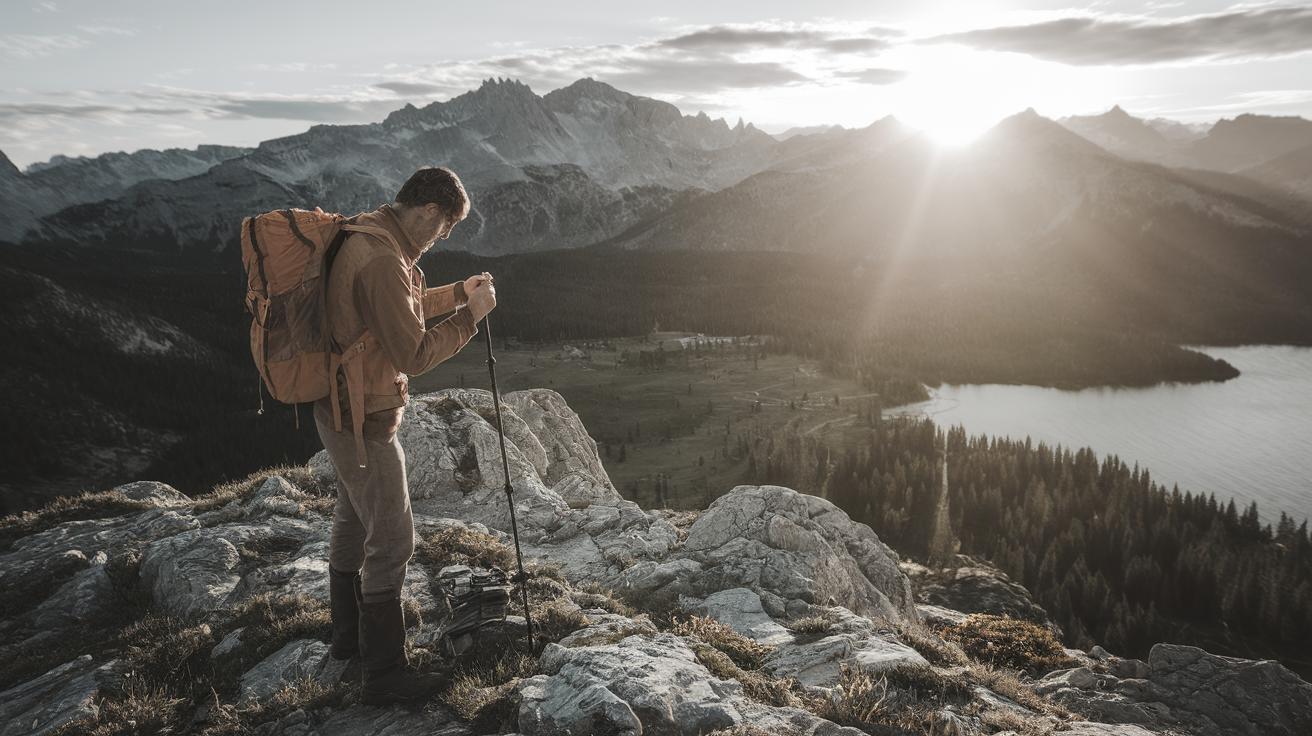How to Tell Direction Without a Compass
In the great outdoors, having the ability to navigate without a compass can be a crucial skill. Whether you’re trekking through forests, traversing mountains, or exploring new terrains, knowing how to find your way using natural markers can enhance your safety and experience. This guide delves into various techniques such as using maps, natural landmarks, the sun, stars, winds, and environmental cues to orient yourself. From identifying handrails and water bodies as guides to understanding how moss grows and how the position of celestial bodies alters with hemispheres, these strategies will equip you with the necessary knowledge for backcountry navigation without a compass.
Start with the Big Picture on the Map
Before venturing into unknown terrain, it’s essential to familiarize yourself with the area’s map. Understanding the landscape’s general layout can help you anticipate and identify major features such as rivers, mountain ranges, or human-made structures. This broader view will serve as your initial framework, helping you visualize the terrain and navigate effectively even when detailed cues are missing.
Focusing on key landmarks and their relative positions will provide reference points during your journey. It’s like creating a mental image of where you will be traveling. This preparation phase is where you establish the context for using additional navigational techniques. Knowing how to read topographical lines can also help you predict elevation changes and potential obstacles, enhancing your overall navigation strategy.
Zoom In on the Map to Identify Handrails
Once you’ve grasped the big picture, the next step is to zoom in on specific map details that function as natural handrails. Handrails are linear features like trails, rivers, or ridges that can guide your route. Identifying these features on the map and in real life helps maintain your intended course and manage progress throughout the journey.
These natural handrails can also be incredibly reassuring under conditions of poor visibility – like fog or dense forest cover – acting as reliable guides that prevent you from straying off course. By thoroughly planning and leveraging such features, you ensure a smoother and more controlled navigation experience, reducing the reliance on a compass.
Let Water Be Your Guide in Backcountry Navigation
Water bodies can serve as excellent navigational aids in the wilderness. Rivers, streams, lakes, and even waterfalls provide clear directional cues. For instance, rivers generally flow downhill, so identifying the flow direction can help determine your relative location and direction.
Moreover, water bodies are frequently situated near trails or other human-made pathways, making them practical reference points during navigation. Understanding the natural hydrology of your map area can also help predict the presence of water, providing crucial context in deciding the direction and scale of your travel.
Use Treeline to Pinpoint Your Elevation
The treeline, which delineates the altitude above which trees cannot grow, varies depending on geographic location and can be a useful indicator of elevation. Recognizing changes in vegetation types as you ascend or descend can assist in estimating your elevation relative to map readings.
In some regions, hiking above the treeline may expose more open terrain, enhancing visibility of distant landmarks and aiding navigation. By correlating visible vegetation zones with those marked on the map, you can confirm your position and adjust your course as necessary.
Navigate with the Sun for Direction of Travel
The sun offers another ancient method of determining direction. By tracking its path across the sky, you can ascertain approximate east-west lines, especially useful during sunrise and sunset. This celestial navigation can support realigning your travel direction when other cues are unavailable.
Use Shadows For Clues on Cloudy Days
Even on cloudy days, shadows – however faint – can reveal direction. By observing the length and angle of shadows cast by objects like trees or rocks, it is possible to infer the position of the sun. This indirect method serves as a backup to determine directions when direct sunlight isn’t available.
Use the Stars to Navigate North and South
Stars have long been vital navigational aids, particularly at night. By locating significant constellations, you can orient yourself naturally. In the Northern Hemisphere, the North Star, or Polaris, is a reliable indicator of true north.
How to Find the North Star
To locate Polaris, identify the Big Dipper constellation; draw a line through its “pointer” stars, and it will approximately lead to the North Star. Knowing how to locate this crucial point helps maintain directional awareness throughout the night.
In the Southern Hemisphere, Use the Southern Cross to Navigate
In the Southern Hemisphere, the Southern Cross constellation serves a similar purpose. By tracing a line along the long axis of the cross constellation, you can determine the general direction of south. This method provides a celestial compass essential for nighttime navigation.
Navigate with the Prevailing Wind
Understanding prevailing wind patterns is another method to ascertain direction, particularly in open landscapes. In many areas, winds are dominated by specific directions owing to regional patterns, which can be utilized as a guide when other cues are minimal.
By observing changes in vegetation, such as wind-swept trees or snowdrifts, you can also infer the direction of consistent winds. Supplementing other navigational tactics with wind awareness can reinforce your sense of orientation in the wild.
Find North and South with Moss
A classic technique involves observing moss, which tends to grow more abundantly on the north side of trees in the Northern Hemisphere. This growth pattern is due to the northern side receiving less sunlight, hence retaining more moisture.
Although not always perfectly aligned, it provides an additional clue towards determining your north-south orientation, especially useful in forested areas. It’s always important to corroborate such observations with additional methods to ensure accuracy.
Pay Attention To Your Surroundings
Keen observation skills can significantly aid navigation. By staying attuned to your environment, noting distinctive rock formations, changes in vegetation, and potential animal trails, you create a mental map of your surroundings.
This heightened situational awareness is invaluable, ensuring you can retrace steps if needed and adapt to new information as you progress. Building a comprehensive understanding of your environment transforms potential hazards into navigational aids.
Watch this 8-minute Tutorial to Learn How to Create a Route in Gaia GPS
For a more modern approach to navigation, digital mapping tools offer valuable resources. An 8-minute tutorial on creating routes in Gaia GPS demonstrates how to leverage technology alongside traditional methods, fully enhancing your navigational toolkit.
A Fond Farewell to National Geographic Maps —…
As technology advances, some classic navigation tools receive less attention. Whilst bidding farewell to physical National Geographic maps might seem bittersweet, it marks a transition to more dynamic mapping solutions like Gaia GPS.
Introducing the Gaia Hike Map: Your Trail-Ready Adventure…
The Gaia Hike Map introduces tailored features for outdoor enthusiasts. With topographic and satellite layers, it combines precision with ease of use, offering a comprehensive view of trails and terrain for informed navigation.
Download the app and get a free 14-day…
By downloading the app, you gain access to a free 14-day trial, providing opportunities to explore its features and capabilities, making it a fantastic complement to traditional navigation techniques.
Gaia GPS is Improving Satellite Imagery: Saying Goodbye…
As Gaia GPS enhances its satellite imagery, users benefit from sharper, more detailed visuals. This improvement simplifies terrain recognition and destination planning, further solidifying its role as an indispensable competitive tool in navigation.
How I Used Gaia GPS to Navigate Italy
Gaia GPS was instrumental during a cultural journey across Italy, seamlessly integrating scenic tours with historical explorations. Its precise tracking and real-time updates ensured successful navigation amid complex cities and countryside alike.
Final Thoughts
| Method | Description |
|---|---|
| Big Picture on the Map | Understand overall terrain features and landmarks. |
| Zoom In on the Map | Identify linear handrails for detailed navigation. |
| Water Bodies | Use them as directional guides and trails indicators. |
| Treeline | Utilized to pinpoint elevation. |
| Sun and Shadows | For general east-west orientation and cloudy day clues. |
| Stars | Navigate by identifying constellations like North Star and Southern Cross. |
| Wind Patterns | Recognize regional winds as direction indicators. |
| Moss Growth | Infer north-south orientation based on growth on trees. |
| Surroundings Awareness | Utilize environmental cues for situational navigation. |
| Gaia GPS | Enhance traditional methods with technological mapping. |


